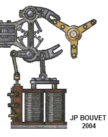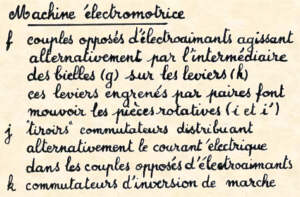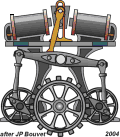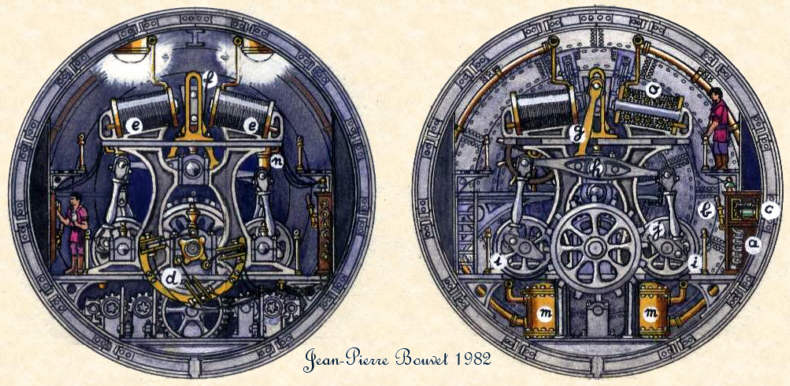|
Jean-Pierre Bouvet's Nautilus Drawings |
| I receive much e-mail about the Nautilus, but this intriguing note, received in July 2004, led to permission to feature Jean-Pierre Bouvet's design here: |
| I made a portfolio of the plans and drawings of the Nautilus in the late 1970 years, according to the descriptions of Pr. Aronnax. It includes plans and elevations, details of the double hull and frame, detailed interior with furniture, an original system with hydraulic cylinder to lower the wheel-house and the light, a complete system of air and water pipes and pumps, even the design of the diving suits, air rifles and electric bullets. There are two complete versions of the engine room with engines inspired by steam-engine-like electric motors of that time. All this has remained unexploited, perhaps the foolishness of a young man.... |
| Here is Bouvet's own discussion of the
design in blue text, illustrated with
details from his beautiful drawings. Jean-Pierre included references
to designs featured in the catalog on this site. Since his design
predated these pages and many of the designs in the catalog, I have
omitted these and leave it to the viewer to find the similarities. Like any
good designer, he has also offered improvements, in part prompted by the
catalog. I have omitted these as well preferring to keep the
description consistent with his original ideas. Any comment or summarization of
my own is clearly noted in [brackets].
The Retractable Wheelhouse |
|
|
|
|
|
The Main Hatch The main hatch is hermetically closed by bolts and folded up when open. When closed, I've imagined a sort of strong metallic girder which can be slid on rails to support the two panels against pressure. The panels are manually operated but Verne's text says that panels were operated "automatically" to replenish the air; so I've envisioned a small auxiliary hatch operated by a piston. [As you examine the graphics illustrating Bouvet's text, note the attendant detail. His document is sixteen pages long, covering every aspect of the boat. The high resolution scanned version is nearly 10 Mbytes.] |
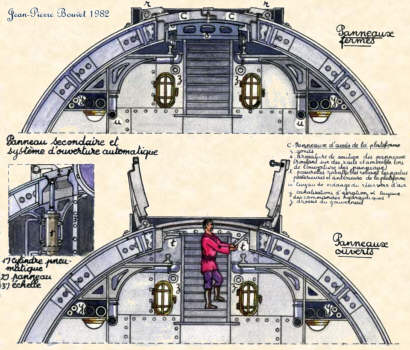 |
|
The Boat The boat is made watertight by rubber seals and secured in its cavity with pressure screws. It has to be "light", "watertight", and pressure resistant, so I thought why not constructed of thick aluminum? Again, the "Gun Club" [of From the Earth to the Moon] is contemporary to this story. I thought also of the possibility of flooding the "canot" by the mean of a pressure valve when the Nautilus dives to a certain depth, the water being expelled by compressed air when returning from depth. The sort of wire coil under the boat, stored in a watertight cavity, is not electromagnetic but just the telegraph wire between the skiff and the Nautilus. |
|
|
|
|
|
The Engine Room I envisioned two versions of the Nautilus engine. The first, crab-like (consistent with Nemo's "all from the sea" statement), is inspired by a little electric engine I saw in the "Arts et Métiers" museum in the 1980's (unfortunately no longer displayed in the recent "modern" reorganization of that museum). Because "un bon dessin vaut mieux qu'un long discours", I've produced a little "cartoon" of its principle of operation. The animation shows only a quarter of the whole engine. |
|
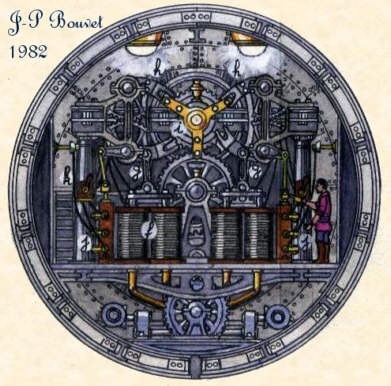
|
On the main axis
there is a second three armed wheel in
phase opposition to the first. Each "wheel" is moved by a pair
of "crab" hooks, each pair moved by two pairs of electromagnets, switched by an
electric inverter inspired by the "tiroir" of steam engines.
|
|
|
|
|
|
|
 |
|
|
Jean-Pierre Bouvet would like your comments and
questions on his Nautilus design. You can reach him at this
e-mail address: jpb.naut@wanadoo.fr
See more of J-P's many Jules Verne drawings on this French-language web site.
|
|
|
Click here to see a detailed (but graphics-heavy, slow-loading) elevation view of the interior. |
|
The sub is also featured in the Nautilus design catalog, including a simple 3D model. |
13 Nov 04
Drawings courtesy of Jean-Pierre
Bouvet
Page content Copyright © 2004 Jean-Pierre Bouvet All rights reserved.
Page format and look Copyright © 2004 Michael & Karen Crisafulli
All rights reserved




